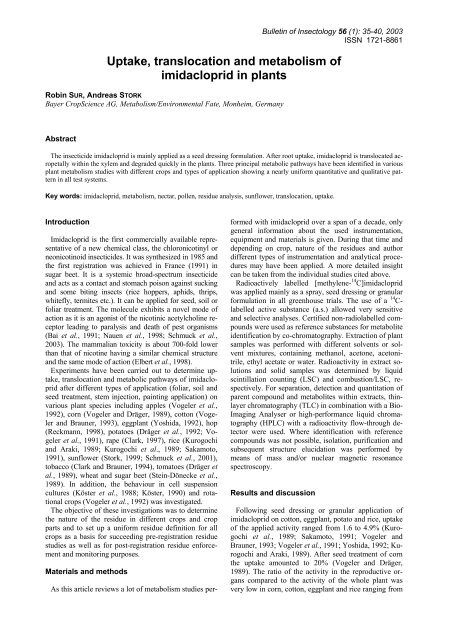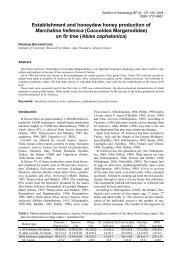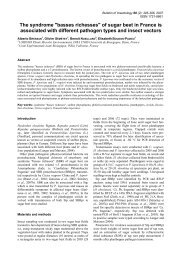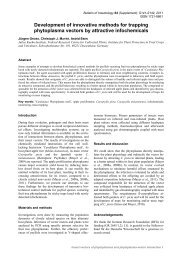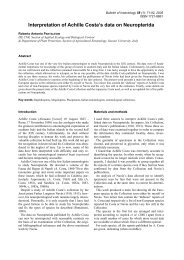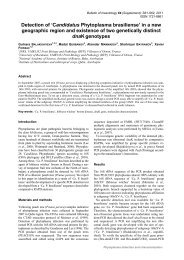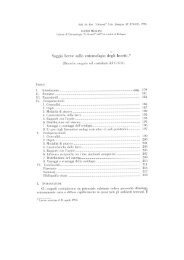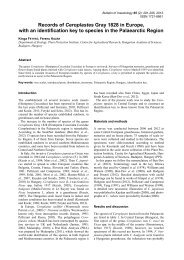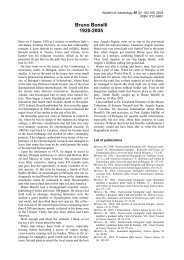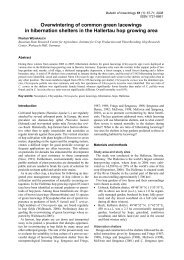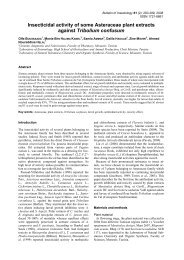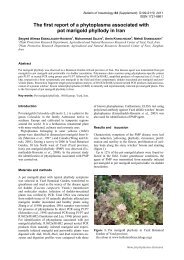Uptake, translocation and metabolism of imidacloprid in plants
Uptake, translocation and metabolism of imidacloprid in plants
Uptake, translocation and metabolism of imidacloprid in plants
Create successful ePaper yourself
Turn your PDF publications into a flip-book with our unique Google optimized e-Paper software.
Bullet<strong>in</strong> <strong>of</strong> Insectology 56 (1): 35-40, 2003<br />
ISSN 1721-8861<br />
<strong>Uptake</strong>, <strong>translocation</strong> <strong>and</strong> <strong>metabolism</strong> <strong>of</strong><br />
<strong>imidacloprid</strong> <strong>in</strong> <strong>plants</strong><br />
Rob<strong>in</strong> SUR, Andreas STORK<br />
Bayer CropScience AG, Metabolism/Environmental Fate, Monheim, Germany<br />
Abstract<br />
The <strong>in</strong>secticide <strong>imidacloprid</strong> is ma<strong>in</strong>ly applied as a seed dress<strong>in</strong>g formulation. After root uptake, <strong>imidacloprid</strong> is translocated acropetally<br />
with<strong>in</strong> the xylem <strong>and</strong> degraded quickly <strong>in</strong> the <strong>plants</strong>. Three pr<strong>in</strong>cipal metabolic pathways have been identified <strong>in</strong> various<br />
plant <strong>metabolism</strong> studies with different crops <strong>and</strong> types <strong>of</strong> application show<strong>in</strong>g a nearly uniform quantitative <strong>and</strong> qualitative pattern<br />
<strong>in</strong> all test systems.<br />
Key words: <strong>imidacloprid</strong>, <strong>metabolism</strong>, nectar, pollen, residue analysis, sunflower, <strong>translocation</strong>, uptake.<br />
Introduction<br />
Imidacloprid is the first commercially available representative<br />
<strong>of</strong> a new chemical class, the chloronicot<strong>in</strong>yl or<br />
neonicot<strong>in</strong>oid <strong>in</strong>secticides. It was synthesized <strong>in</strong> 1985 <strong>and</strong><br />
the first registration was achieved <strong>in</strong> France (1991) <strong>in</strong><br />
sugar beet. It is a systemic broad-spectrum <strong>in</strong>secticide<br />
<strong>and</strong> acts as a contact <strong>and</strong> stomach poison aga<strong>in</strong>st suck<strong>in</strong>g<br />
<strong>and</strong> some bit<strong>in</strong>g <strong>in</strong>sects (rice hoppers, aphids, thrips,<br />
whitefly, termites etc.). It can be applied for seed, soil or<br />
foliar treatment. The molecule exhibits a novel mode <strong>of</strong><br />
action as it is an agonist <strong>of</strong> the nicot<strong>in</strong>ic acetylchol<strong>in</strong>e receptor<br />
lead<strong>in</strong>g to paralysis <strong>and</strong> death <strong>of</strong> pest organisms<br />
(Bai et al., 1991; Nauen et al., 1998; Schmuck et al.,<br />
2003). The mammalian toxicity is about 700-fold lower<br />
than that <strong>of</strong> nicot<strong>in</strong>e hav<strong>in</strong>g a similar chemical structure<br />
<strong>and</strong> the same mode <strong>of</strong> action (Elbert et al., 1998).<br />
Experiments have been carried out to determ<strong>in</strong>e uptake,<br />
<strong>translocation</strong> <strong>and</strong> metabolic pathways <strong>of</strong> <strong>imidacloprid</strong><br />
after different types <strong>of</strong> application (foliar, soil <strong>and</strong><br />
seed treatment, stem <strong>in</strong>jection, pa<strong>in</strong>t<strong>in</strong>g application) on<br />
various plant species <strong>in</strong>clud<strong>in</strong>g apples (Vogeler et al.,<br />
1992), corn (Vogeler <strong>and</strong> Dräger, 1989), cotton (Vogeler<br />
<strong>and</strong> Brauner, 1993), eggplant (Yoshida, 1992), hop<br />
(Reckmann, 1998), potatoes (Dräger et al., 1992; Vogeler<br />
et al., 1991), rape (Clark, 1997), rice (Kurogochi<br />
<strong>and</strong> Araki, 1989; Kurogochi et al., 1989; Sakamoto,<br />
1991), sunflower (Stork, 1999; Schmuck et al., 2001),<br />
tobacco (Clark <strong>and</strong> Brauner, 1994), tomatoes (Dräger et<br />
al., 1989), wheat <strong>and</strong> sugar beet (Ste<strong>in</strong>-Dönecke et al.,<br />
1989). In addition, the behaviour <strong>in</strong> cell suspension<br />
cultures (Köster et al., 1988; Köster, 1990) <strong>and</strong> rotational<br />
crops (Vogeler et al., 1992) was <strong>in</strong>vestigated.<br />
The objective <strong>of</strong> these <strong>in</strong>vestigations was to determ<strong>in</strong>e<br />
the nature <strong>of</strong> the residue <strong>in</strong> different crops <strong>and</strong> crop<br />
parts <strong>and</strong> to set up a uniform residue def<strong>in</strong>ition for all<br />
crops as a basis for succeed<strong>in</strong>g pre-registration residue<br />
studies as well as for post-registration residue enforcement<br />
<strong>and</strong> monitor<strong>in</strong>g purposes.<br />
Materials <strong>and</strong> methods<br />
As this article reviews a lot <strong>of</strong> <strong>metabolism</strong> studies per-<br />
formed with <strong>imidacloprid</strong> over a span <strong>of</strong> a decade, only<br />
general <strong>in</strong>formation about the used <strong>in</strong>strumentation,<br />
equipment <strong>and</strong> materials is given. Dur<strong>in</strong>g that time <strong>and</strong><br />
depend<strong>in</strong>g on crop, nature <strong>of</strong> the residues <strong>and</strong> author<br />
different types <strong>of</strong> <strong>in</strong>strumentation <strong>and</strong> analytical procedures<br />
may have been applied. A more detailed <strong>in</strong>sight<br />
can be taken from the <strong>in</strong>dividual studies cited above.<br />
Radioactively labelled [methylene- 14 C]<strong>imidacloprid</strong><br />
was applied ma<strong>in</strong>ly as a spray, seed dress<strong>in</strong>g or granular<br />
formulation <strong>in</strong> all greenhouse trials. The use <strong>of</strong> a 14 Clabelled<br />
active substance (a.s.) allowed very sensitive<br />
<strong>and</strong> selective analyses. Certified non-radiolabelled compounds<br />
were used as reference substances for metabolite<br />
identification by co-chromatography. Extraction <strong>of</strong> plant<br />
samples was performed with different solvents or solvent<br />
mixtures, conta<strong>in</strong><strong>in</strong>g methanol, acetone, acetonitrile,<br />
ethyl acetate or water. Radioactivity <strong>in</strong> extract solutions<br />
<strong>and</strong> solid samples was determ<strong>in</strong>ed by liquid<br />
sc<strong>in</strong>tillation count<strong>in</strong>g (LSC) <strong>and</strong> combustion/LSC, respectively.<br />
For separation, detection <strong>and</strong> quantitation <strong>of</strong><br />
parent compound <strong>and</strong> metabolites with<strong>in</strong> extracts, th<strong>in</strong>layer<br />
chromatography (TLC) <strong>in</strong> comb<strong>in</strong>ation with a Bio-<br />
Imag<strong>in</strong>g Analyser or high-performance liquid chromatography<br />
(HPLC) with a radioactivity flow-through detector<br />
were used. Where identification with reference<br />
compounds was not possible, isolation, purification <strong>and</strong><br />
subsequent structure elucidation was performed by<br />
means <strong>of</strong> mass <strong>and</strong>/or nuclear magnetic resonance<br />
spectroscopy.<br />
Results <strong>and</strong> discussion<br />
Follow<strong>in</strong>g seed dress<strong>in</strong>g or granular application <strong>of</strong><br />
<strong>imidacloprid</strong> on cotton, eggplant, potato <strong>and</strong> rice, uptake<br />
<strong>of</strong> the applied activity ranged from 1.6 to 4.9% (Kurogochi<br />
et al., 1989; Sakamoto, 1991; Vogeler <strong>and</strong><br />
Brauner, 1993; Vogeler et al., 1991; Yoshida, 1992; Kurogochi<br />
<strong>and</strong> Araki, 1989). After seed treatment <strong>of</strong> corn<br />
the uptake amounted to 20% (Vogeler <strong>and</strong> Dräger,<br />
1989). The ratio <strong>of</strong> the activity <strong>in</strong> the reproductive organs<br />
compared to the activity <strong>of</strong> the whole plant was<br />
very low <strong>in</strong> corn, cotton, eggplant <strong>and</strong> rice rang<strong>in</strong>g from
0.7 to 1.4%; <strong>in</strong> potato this ratio amounted to 12% (table<br />
1).<br />
<strong>Uptake</strong> <strong>and</strong> <strong>translocation</strong> have also been studied after<br />
spray application <strong>of</strong> <strong>imidacloprid</strong> 25 WP on apple <strong>and</strong><br />
tomato (Vogeler et al, 1992; Dräger et al., 1989). Fourteen<br />
days after the treatment <strong>of</strong> apple <strong>and</strong> tomato fruits<br />
28 <strong>and</strong> 21% <strong>of</strong> the applied activity, respectively, was<br />
recovered <strong>in</strong> or on the fruits; between 65 <strong>and</strong> 76% <strong>of</strong><br />
36<br />
this recovered activity was located on the surface <strong>of</strong> the<br />
fruits (table 2). In additional <strong>translocation</strong> experiments<br />
the a.s. was applied only onto apple <strong>and</strong> tomato leaves,<br />
while the fruits were covered with plastic foil dur<strong>in</strong>g the<br />
application to prevent contam<strong>in</strong>ation. At harvest, 14<br />
days later, the amount <strong>of</strong> radioactivity <strong>in</strong> the fruit compared<br />
to the activity applied was 0.1% at maximum<br />
(Vogeler et al., 1992; Dräger et al., 1989).<br />
Table 1. <strong>Uptake</strong>, distribution <strong>and</strong> ma<strong>in</strong> metabolites <strong>of</strong> <strong>imidacloprid</strong> after soil application/seed treatment (TRR: total<br />
radioactive residue, 6-CNA: 6-chloronicot<strong>in</strong>ic acid, 6-CPA: 6-chloropicolyl alcohol, *Nitrosim<strong>in</strong>e1% <strong>of</strong> TRR)<br />
Apple fruit 14 28 65<br />
Imidacloprid, Olef<strong>in</strong>e, 5-Hydroxy, Guanid<strong>in</strong>e,<br />
6-CPA-Glucoside, Urea, Dihydroxy<br />
Tomato fruit 14 21 76 Imidacloprid, Guanid<strong>in</strong>e, Urea, 5-Hydroxy<br />
TRR: total radioactive residue<br />
Table 3. Residues <strong>of</strong> <strong>imidacloprid</strong>, hydroxy- (4- <strong>and</strong> 5-hydroxy) <strong>and</strong> olef<strong>in</strong>e-metabolites <strong>in</strong> nectar <strong>and</strong> pollen samples<br />
<strong>of</strong> corn, sunflower <strong>and</strong> summer rape (field trial results).<br />
Crop Formulation<br />
Corn<br />
WS 70<br />
1 trial (France) 1 mg a.s./seed<br />
Sunflower<br />
WS 70<br />
2 trials (Germany) 0.7 mg a.s./seed<br />
Summer Rape<br />
3 trials<br />
(France, Sweden, UK)<br />
FS 500<br />
0.04 mg a.s./seed<br />
a.s.: active substance (=<strong>imidacloprid</strong>)<br />
Sample<br />
Material<br />
Residues <strong>in</strong> treated <strong>and</strong> control samples [mg/kg]<br />
Imidacloprid Hydroxy-metab. Olef<strong>in</strong>e-metab.<br />
Pollen
Translocation experiments exam<strong>in</strong>e the mobility <strong>and</strong><br />
distribution <strong>of</strong> chemical compounds with<strong>in</strong> the vascular<br />
system <strong>and</strong> the tissues <strong>of</strong> <strong>plants</strong>. The results <strong>of</strong><br />
these experiments for <strong>imidacloprid</strong> with different application<br />
types show, that there is a good acropetal<br />
<strong>translocation</strong> <strong>of</strong> the a.s. to shoots <strong>and</strong> leaves (excellent<br />
xylem mobility) on the one h<strong>and</strong> <strong>and</strong> on the other h<strong>and</strong><br />
a poor basipetal <strong>translocation</strong> to s<strong>in</strong>ks, i.e. storage organs,<br />
roots <strong>and</strong> fruits (negligible phloem mobility).<br />
Consequently, highest residues are expected to occur<br />
<strong>in</strong> the older leaf parts <strong>of</strong> the <strong>plants</strong>. The systemic properties<br />
<strong>of</strong> a molecule are a function <strong>of</strong> its physicochemical<br />
properties, ma<strong>in</strong>ly water solubility, octanol/water-partition<br />
coefficient (log POW) <strong>and</strong> dissociation<br />
constant (pKa) determ<strong>in</strong><strong>in</strong>g e.g. its ability to<br />
penetrate through biomembranes. These properties are<br />
responsible for the k<strong>in</strong>etics <strong>of</strong> root uptake <strong>and</strong> <strong>translocation</strong><br />
<strong>in</strong>to the xylem, which is a prerequisite for enter<strong>in</strong>g<br />
the phloem <strong>and</strong> <strong>in</strong> turn to be taken up by suck<strong>in</strong>g<br />
<strong>in</strong>sects. Accord<strong>in</strong>g to the BRIGGS model (Briggs et<br />
al., 1982) the load<strong>in</strong>g <strong>of</strong> the xylem by organic compounds<br />
due to root-systemic uptake can be described<br />
by a bell-shaped curve with maximum xylem mobility<br />
between log POW <strong>of</strong> 1.0 <strong>and</strong> 2.5. As a measure <strong>of</strong> xylem<br />
mobility the transpiration stream concentration<br />
factor (TSCF) has been <strong>in</strong>troduced relat<strong>in</strong>g the concentration<br />
<strong>of</strong> the compound <strong>in</strong> the transpiration stream<br />
(xylem) to the exposure concentration. This model<br />
predicts for <strong>imidacloprid</strong> with log POW = 0.51 a considerable<br />
high xylem mobility <strong>of</strong> about TSCF = 0.6,<br />
Cl<br />
N<br />
N NH<br />
N<br />
Imidacloprid<br />
NO 2<br />
Cl<br />
N<br />
HO<br />
which was qualitatively confirmed <strong>in</strong> the <strong>translocation</strong><br />
experiments mentioned above.<br />
Xylem <strong>and</strong> phloem have different pH values <strong>of</strong> about<br />
5 <strong>and</strong> 8, respectively. Therefore, especially weak acids<br />
with pKa values <strong>of</strong> about 5.0-5.5 <strong>and</strong> log POW between<br />
1.0 <strong>and</strong> 2.5 (molecules with this lipophilicity properties<br />
can cross membranes very easily), e.g. 6-chloronicot<strong>in</strong>ic<br />
acid, tend to accumulate <strong>in</strong> the phloem sieve tubes (ion<br />
trap mechanism). Imidacloprid with its high pKa <strong>of</strong> 14 is<br />
nonionized <strong>and</strong> therefore these pH differences do not<br />
affect the distribution between the compartments <strong>and</strong><br />
the a.s. moves freely between phloem <strong>and</strong> xylem accord<strong>in</strong>g<br />
to its biomembrane permeability. However,<br />
s<strong>in</strong>ce there is no active load<strong>in</strong>g <strong>of</strong> <strong>imidacloprid</strong> to the<br />
phloem <strong>and</strong> due to the far greater water flow (50- to<br />
100-fold) <strong>imidacloprid</strong> is predom<strong>in</strong>antly transported<br />
with<strong>in</strong> the xylem vessels (Bromilow <strong>and</strong> Chamberla<strong>in</strong>,<br />
1989). Once <strong>imidacloprid</strong> has entered the leaves it will<br />
be trapped by this counter current pr<strong>in</strong>ciple <strong>in</strong> the leaf<br />
<strong>and</strong> not re-transported <strong>in</strong>to the plant stem.<br />
Despite the wide variety <strong>of</strong> crops <strong>and</strong> application<br />
types hav<strong>in</strong>g been <strong>in</strong>vestigated a rather uniform picture<br />
<strong>of</strong> the metabolic behaviour <strong>of</strong> <strong>imidacloprid</strong> <strong>in</strong> <strong>plants</strong> was<br />
found consist<strong>in</strong>g <strong>of</strong> three pr<strong>in</strong>cipal biotransformation<br />
pathways (figures 1-3). Especially after soil application<br />
or seed treatment a quick degradation <strong>of</strong> the a.s. was observed<br />
after root uptake <strong>of</strong> the a.s. In the case <strong>of</strong> spray<br />
application only a part <strong>of</strong> the a.s. is translocated <strong>in</strong>to the<br />
plant <strong>and</strong> metabolized there, so the degree <strong>of</strong> <strong>metabolism</strong><br />
tends to be lower <strong>in</strong> this case.<br />
N NH<br />
N<br />
5(4)-Hydroxy<br />
NO 2<br />
(OH)<br />
Cl<br />
Cl<br />
Cl<br />
N<br />
N<br />
N<br />
Olef<strong>in</strong>e<br />
N NH<br />
N<br />
HO OH<br />
N NH<br />
N<br />
4,5-Dihydroxy<br />
conj.<br />
O<br />
NO 2<br />
NO 2<br />
N NH<br />
N<br />
NO 2<br />
5-Hydroxy-conjugate<br />
Figure 1. Metabolism <strong>of</strong> <strong>imidacloprid</strong> (I): ethylene-bridge hydroxylation <strong>of</strong> the imidazolid<strong>in</strong>e r<strong>in</strong>g <strong>and</strong> elim<strong>in</strong>ation <strong>of</strong><br />
water.<br />
37
Cl<br />
38<br />
N<br />
N NH<br />
N<br />
Imidacloprid<br />
(Nitroguanid<strong>in</strong>e)<br />
NO 2<br />
Cl<br />
Cl<br />
Cl<br />
N NH<br />
N N<br />
NO<br />
Nitrosim<strong>in</strong>e<br />
N<br />
N NH<br />
Am<strong>in</strong>oguanid<strong>in</strong>e<br />
N<br />
N N<br />
Triaz<strong>in</strong>one<br />
N<br />
NH 2<br />
N N<br />
O<br />
Cl<br />
Cl<br />
N<br />
Guanid<strong>in</strong>e<br />
N<br />
N NH<br />
Urea<br />
NH<br />
N NH<br />
O<br />
Cl<br />
N<br />
N<br />
H<br />
NH<br />
NH 2<br />
R<strong>in</strong>g-open-guanid<strong>in</strong>e<br />
Bound residues<br />
Figure 2. Metabolism <strong>of</strong> <strong>imidacloprid</strong> (II): nitro-group reduction to nitrosim<strong>in</strong>e <strong>and</strong> further loss <strong>of</strong> NO to form guanid<strong>in</strong>e.<br />
Cl<br />
N NH<br />
N N<br />
NO2 Imidacloprid<br />
Cl<br />
N<br />
Cl<br />
Cl<br />
N<br />
O<br />
HO<br />
Glucoside<br />
O<br />
OH<br />
OH<br />
6-Chloropicolyl alcohol<br />
(6-CPA)<br />
N<br />
OH<br />
OH<br />
O conj.<br />
Cl<br />
Cl<br />
N<br />
N<br />
O<br />
O<br />
HO<br />
O<br />
Gentiobioside<br />
OH<br />
6-Chloronicot<strong>in</strong>ic acid<br />
(6-CNA)<br />
OH<br />
OH<br />
HO<br />
O<br />
O<br />
OH<br />
OH<br />
OH<br />
Bound residues<br />
Figure 3. Metabolism <strong>of</strong> <strong>imidacloprid</strong> (III): Oxidative cleavage <strong>of</strong> the methylene bridge to form 6-chloropicolyl alcohol<br />
<strong>and</strong> subsequent oxidation to 6-chloronicot<strong>in</strong>ic acid.<br />
In figure 1 the ethylene-bridge hydroxylation at the<br />
imidazolid<strong>in</strong>e (dihydroimidazole) r<strong>in</strong>g <strong>of</strong> the a.s. leads<br />
to the formation <strong>of</strong> the hydroxy-metabolite, which<br />
ma<strong>in</strong>ly undergoes a subsequent dehydration to form the<br />
olef<strong>in</strong>e-compound. Secondly, as depicted <strong>in</strong> figure 2, a<br />
nitro-group reduction takes place to form the nitrosim<strong>in</strong>e<br />
compound. In a further step, after loss <strong>of</strong> the<br />
NO-group the cyclic guanid<strong>in</strong>e <strong>and</strong> urea metabolites are<br />
formed. Start<strong>in</strong>g with nitrosim<strong>in</strong>e a cyclisation with en-<br />
dogeneous pyruvic acid (created <strong>in</strong> respiration dur<strong>in</strong>g<br />
glycolysis) to the triaz<strong>in</strong>one metabolite via a supposed<br />
but not found am<strong>in</strong>oguanid<strong>in</strong>e <strong>in</strong>termediate occurs.<br />
However, m<strong>in</strong>ute amounts <strong>of</strong> this compound were found<br />
only <strong>in</strong> potato leaves. Thirdly, <strong>imidacloprid</strong> is oxidized<br />
to 6-chloropicolyl alcohol <strong>and</strong> <strong>in</strong> turn to 6chloronicot<strong>in</strong>ic<br />
acid. In addition, alcohol conjugates<br />
with glucose <strong>and</strong> isomaltose to glucopyranoside <strong>and</strong><br />
gentiobioside, respectively, are also formed (figure 3).
In the reproductive organs <strong>of</strong> seed-treated crop <strong>plants</strong>,<br />
only very low amounts <strong>of</strong> <strong>imidacloprid</strong> metabolites<br />
were detected. Based on the quantitative aspect the 5hydroxy-,<br />
olef<strong>in</strong>e-, dihydroxy-, urea- <strong>and</strong> 6-CNAmetabolite<br />
were most commonly found <strong>in</strong> these parts <strong>of</strong><br />
seed-dressed crop <strong>plants</strong>.<br />
It has to be mentioned that the f<strong>in</strong>d<strong>in</strong>gs <strong>of</strong> the <strong>metabolism</strong><br />
<strong>and</strong> <strong>translocation</strong> experiments reflect worst-case<br />
scenarios <strong>and</strong> that under practical field conditions lower<br />
amounts <strong>of</strong> metabolites <strong>and</strong> a more rapid degradation<br />
are observed. This is on the one h<strong>and</strong> due to UVphotolysis<br />
<strong>and</strong> weather conditions be<strong>in</strong>g only <strong>of</strong> negligible<br />
importance <strong>in</strong> greenhouse trials <strong>and</strong> the low<br />
amount <strong>of</strong> soil <strong>in</strong> the plant boxes compared to the root<br />
mass caus<strong>in</strong>g exaggerated uptake <strong>of</strong> <strong>imidacloprid</strong>.<br />
As far as bee-relevant matrices are concerned, a <strong>metabolism</strong><br />
study <strong>in</strong> sunflower after seed-dress<strong>in</strong>g with<br />
<strong>imidacloprid</strong> WS 70 was carried out (Stork, 1999;<br />
Schmuck et al., 2001). The applied amount was 0.79 mg<br />
a.s./seed. Dur<strong>in</strong>g flower<strong>in</strong>g, the nectar was collected<br />
after sampl<strong>in</strong>g the female florets from the <strong>in</strong>florescence<br />
by tweezers <strong>and</strong> extract<strong>in</strong>g the nectar us<strong>in</strong>g glass capillaries.<br />
Pollen samples were collected <strong>in</strong> plastic boxes<br />
fixed below the <strong>in</strong>florescences before flower<strong>in</strong>g. The<br />
total radioactive residue (TRR) <strong>in</strong> nectar <strong>and</strong> pollen was<br />
very low <strong>and</strong> amounted to 0.0019 <strong>and</strong> 0.0039 mg/kg,<br />
expressed as parent compound equivalents, respectively.<br />
In nectar 100% <strong>of</strong> the TRR consisted <strong>of</strong> <strong>imidacloprid</strong>. In<br />
pollen, the whole extractable radioactivity (85.8%,<br />
0.0033 mg/kg) represented <strong>imidacloprid</strong>. The rema<strong>in</strong><strong>in</strong>g<br />
radioactivity <strong>in</strong> pollen (= non-extractable residues) was<br />
not further analysed due to the very low absolute<br />
amount. As only <strong>imidacloprid</strong> was found <strong>in</strong> the <strong>metabolism</strong><br />
study, this was considered as the only relevant<br />
residue <strong>in</strong> those sample materials <strong>and</strong> consequently, the<br />
residue def<strong>in</strong>ition was expressed as “parent only”.<br />
Field-residue trials with non-labelled <strong>imidacloprid</strong> on<br />
sunflower, corn <strong>and</strong> rape were additionally carried out<br />
to confirm the f<strong>in</strong>d<strong>in</strong>gs <strong>of</strong> the <strong>metabolism</strong> study under<br />
practical conditions (Schmuck, 1999). The samples <strong>of</strong><br />
these studies were not only analyzed for <strong>imidacloprid</strong><br />
but also for hydroxy- <strong>and</strong> olef<strong>in</strong>e-metabolites, as these<br />
compounds also show biological activity aga<strong>in</strong>st certa<strong>in</strong><br />
<strong>in</strong>sect species (Nauen et al., 1999; Nauen et al., 2001).<br />
The results <strong>of</strong> all six field trials are compiled <strong>in</strong> table 3.<br />
Neither <strong>in</strong> pollen nor <strong>in</strong> nectar samples <strong>of</strong> corn, sunflower<br />
<strong>and</strong> summer rape any residues <strong>of</strong> <strong>imidacloprid</strong><br />
<strong>and</strong> the two other metabolites have been determ<strong>in</strong>ed<br />
above the limit <strong>of</strong> quantitation (LOQ <strong>of</strong> <strong>imidacloprid</strong><br />
<strong>and</strong> hydroxy-<strong>imidacloprid</strong> = 0.005 mg/kg, LOQ <strong>of</strong> olef<strong>in</strong>e<br />
metabolite = 0.01 mg/kg).<br />
Conclusions<br />
More than 15 studies with <strong>imidacloprid</strong> have been carried<br />
out concern<strong>in</strong>g uptake, <strong>translocation</strong> <strong>and</strong> <strong>metabolism</strong><br />
<strong>in</strong> various plant species ma<strong>in</strong>ly after foliar, soil or<br />
seed treatment. The uptake after soil or seed treatment is<br />
about 5% <strong>of</strong> the applied dose <strong>and</strong> the a.s. shows good<br />
acropetal mobility with<strong>in</strong> the xylem <strong>and</strong> poor basipetal<br />
<strong>translocation</strong> with<strong>in</strong> the phloem. Three pr<strong>in</strong>cipal meta-<br />
bolic pathways <strong>of</strong> <strong>imidacloprid</strong> <strong>in</strong> <strong>plants</strong> were identified<br />
show<strong>in</strong>g a quick degradation <strong>of</strong> the a.s., especially after<br />
seed or soil application. The f<strong>in</strong>d<strong>in</strong>gs <strong>of</strong> the <strong>metabolism</strong><br />
studies show a clear <strong>and</strong> consistent picture. It can be<br />
concluded that <strong>in</strong> nearly all crops the metabolic pathway<br />
<strong>of</strong> <strong>imidacloprid</strong> runs via the same three routes <strong>and</strong> results<br />
<strong>in</strong> qualitative <strong>and</strong> quantitative similar composition<br />
<strong>of</strong> the metabolic spectrum. All identified metabolites<br />
still conta<strong>in</strong> the 6-chloropicolyl moiety <strong>of</strong> <strong>imidacloprid</strong>.<br />
Hence, the relevant residue to be analysed <strong>in</strong> field residue<br />
trials can be def<strong>in</strong>ed as the sum <strong>of</strong> <strong>imidacloprid</strong> <strong>and</strong><br />
its metabolites conta<strong>in</strong><strong>in</strong>g the 6-chloropicolyl moiety,<br />
expressed as <strong>imidacloprid</strong>.<br />
The nature <strong>of</strong> the residue <strong>in</strong> bee-relevant matrices <strong>of</strong><br />
oilseeds (sunflower nectar <strong>and</strong> pollen) was determ<strong>in</strong>ed<br />
to consist <strong>of</strong> the parent compound <strong>imidacloprid</strong> only.<br />
Field residue trials with <strong>imidacloprid</strong> after seed-dress<strong>in</strong>g<br />
<strong>of</strong> sunflower, corn <strong>and</strong> rape revealed that no residues<br />
above the limit <strong>of</strong> quantitation <strong>of</strong> the residue analytical<br />
method were present <strong>in</strong> pollen <strong>and</strong> nectar.<br />
Acknowledgements<br />
Thanks are expressed to all persons hav<strong>in</strong>g been <strong>in</strong>volved<br />
<strong>in</strong> the successful development <strong>of</strong> <strong>imidacloprid</strong>.<br />
References<br />
BAI D., LUMMIS S. C. R., LEICHT W., BREER H., SATTELLE D.<br />
B., 1991.- Actions <strong>of</strong> <strong>imidacloprid</strong> <strong>and</strong> a related nitromethylene<br />
on chol<strong>in</strong>ergic receptors <strong>of</strong> an identified <strong>in</strong>sect motor<br />
neurone.- Pestic. Sci., 33: 197-204.<br />
BRIGGS G. G., BROMILOW R. H. AND EVANS A. A., 1982.- Relationships<br />
between lipophilicity <strong>and</strong> root uptake <strong>and</strong> <strong>translocation</strong><br />
<strong>of</strong> non-ionised chemicals by barley.- Pestic. Sci.,<br />
13: 495-504.<br />
BROMILOW R. H., CHAMBERLAIN K., 1989.- Design<strong>in</strong>g molecules<br />
for systemicity.- In: Mechanisms <strong>and</strong> regulation <strong>of</strong><br />
Transport Processes (ATKIN R.K., CLIFFORD D.R., Eds),<br />
Monograph 18, British Plant Growth Regulator Group.<br />
CLARK T., 1997.- <strong>Uptake</strong> <strong>of</strong> NTN 33893 <strong>in</strong> Phacelia <strong>and</strong><br />
Summer Rape.- Unpublished report no. 4293, Bayer Crop-<br />
Science AG, Metabolism/Environmental Fate, Monheim,<br />
Germany.<br />
CLARK T., BRAUNER A., 1994.- Metabolism <strong>of</strong> NTN 33893 <strong>in</strong><br />
Tobacco.- Unpublished report no. 3997, Bayer CropScience<br />
AG, Metabolism/Environmental Fate, Monheim, Germany.<br />
DRÄGER G., BRAUNER A., BORNATSCH W., 1989.- NTN<br />
33893: Metabolism <strong>in</strong> tomatoes.- Unpublished report no.<br />
3257, Bayer CropScience AG, Metabolism/Environmental<br />
Fate, Monheim, Germany.<br />
DRÄGER G., BORNATSCH W., BRAUNER A., 1992.- Study on the<br />
Metabolism <strong>of</strong> NTN 33893 after Spray Application to Potatoes.-<br />
Unpublished report no. 3678, Bayer CropScience AG,<br />
Metabolism/Environmental Fate, Monheim, Germany.<br />
ELBERT A., NAUEN R., LEICHT W., 1998.- Imidacloprid, a<br />
novel chloronicot<strong>in</strong>yl <strong>in</strong>secticide: biological activity <strong>and</strong> agricultural<br />
importance.- In: Insecticides with novel modes <strong>of</strong><br />
action: Mechanism <strong>and</strong> application (ISHAAYA I., DEGHEELE<br />
D., Eds), Spr<strong>in</strong>ger Verlag, Berl<strong>in</strong> Heidelberg, Germany, 50-<br />
74.<br />
KÖSTER J., BORNATSCH W., BRAUNER A., 1988.- Metabolism<br />
<strong>of</strong> [pyrid<strong>in</strong>yl-14C-methyl]NTN 33893 <strong>in</strong> Potato, Wheat <strong>and</strong><br />
39
Corn Cell Suspension Cultures.- Unpublished report ID M<br />
1710181-9, Bayer CropScience AG, Metabolism/Environmental<br />
Fate, Monheim, Germany.<br />
KÖSTER J., 1990.- Comparative Metabolism <strong>of</strong> [pyrid<strong>in</strong>yl-<br />
14 C]NTN 33893 <strong>in</strong> plant cell suspension cultures.- Unpublished<br />
report no. 3667, Bayer CropScience AG, Metabolism/Environmental<br />
Fate, Monheim, Germany.<br />
KUROGOCHI S. AND ARAKI Y., 1989.- Isolation <strong>and</strong> Identification<br />
<strong>of</strong> Metabolites <strong>of</strong> NTN 33893 <strong>in</strong> Rice by Water Culture.-<br />
Unpublished report no. 1282, Nihon Bayer Agrochem<br />
K.K., Yuki Research Center, Environmental Science Research,<br />
Yuki, Ibaraki, Japan.<br />
KUROGOCHI S., MARUYAMA M., ARAKI Y., 1989.- Absorption<br />
<strong>and</strong> Translocation <strong>of</strong> 14 C-NTN 33893 <strong>in</strong> Egg<strong>plants</strong> <strong>and</strong> Rice<br />
Plants.- Unpublished report no. 1273, Nihon Bayer Agrochem<br />
K.K., Yuki Research Center, Environmental Science<br />
Research, Yuki, Ibaraki, Japan.<br />
NAUEN R., TOLLO B., TIETJEN K., ELBERT A., 1998.- Antifeedant<br />
effect, biological efficacy <strong>and</strong> high aff<strong>in</strong>ity b<strong>in</strong>d<strong>in</strong>g<br />
<strong>of</strong> <strong>imidacloprid</strong> to acetylchol<strong>in</strong>e receptors <strong>in</strong> Myzus persicae<br />
<strong>and</strong> Myzus nicotianae.- Pestic. Sci., 51: 52-56.<br />
NAUEN R., RECKMANN U., ARMBROST S., STUPP H.-P., ELBERT<br />
A, 1999.- Whitefly-active metabolites <strong>of</strong> <strong>imidacloprid</strong>: biological<br />
efficacy <strong>and</strong> <strong>translocation</strong> <strong>in</strong> cotton <strong>plants</strong>.- Pestic.<br />
Sci., 55: 265-71.<br />
NAUEN R., EBBINGHAUS-KINTSCHER U., SCHMUCK R., 2001.-<br />
Toxicity <strong>and</strong> nicot<strong>in</strong>ic acetylchol<strong>in</strong>e receptor <strong>in</strong>teraction <strong>of</strong><br />
<strong>imidacloprid</strong> <strong>and</strong> ist metabolites <strong>in</strong> Apis mellifera (Hymenoptera:<br />
Apidae).- Pest. Manag. Sci., 57: 577-586.<br />
RECKMANN U., 1998.- Translocation <strong>of</strong> 14 C-<strong>imidacloprid</strong> <strong>in</strong><br />
hop after stem application (translated title; report available<br />
<strong>in</strong> German language).- Unpublished report no. RMU 501,<br />
Bayer CropScience AG, Formulation Development, Monheim,<br />
Germany.<br />
SAKAMOTO H., 1991.- Metabolism <strong>of</strong> [pyridyl- 14 C-methyl]<br />
NTN33893 <strong>in</strong> Rice Plants (Nursery Box Application).- Unpublished<br />
report no. 1284, Nihon Bayer Agrochem K.K.,<br />
Yuki Research Center, Environmental Science Research,<br />
Yuki, Ibaraki, Japan.<br />
SCHMUCK R., 1999.- No causal relationship between Gaucho ®<br />
seed dress<strong>in</strong>g <strong>in</strong> sunflowers <strong>and</strong> the French bee malady.-<br />
Pflanzenschutz-Nachrichten Bayer, 52(3): 267-309.<br />
SCHMUCK R., SCHÖNING R., STORK A., SCHRAMEL O., 2001.-<br />
Risk posed to honeybees (Apis mellifera L, Hymenoptera)<br />
by an <strong>imidacloprid</strong> seed dress<strong>in</strong>g <strong>of</strong> sunflowers.- Pest.<br />
Manag. Sci., 57: 225-238.<br />
40<br />
SCHMUCK R., NAUEN R., EBBINGHAUS-KINTSCHER U., 2003.-<br />
Effects <strong>of</strong> <strong>imidacloprid</strong> <strong>and</strong> common plant metabolites <strong>of</strong><br />
<strong>imidacloprid</strong> <strong>in</strong> the honeybee: toxicological <strong>and</strong> biochemical<br />
considerations.- In: Proceed<strong>in</strong>gs <strong>of</strong> the 8 th International<br />
Symposium “Hazards <strong>of</strong> pesticides to bees”, September 4-<br />
6, 2002, Bologna, Italy (PORRINI C., BORTOLOTTI L., Eds).<br />
Bullet<strong>in</strong> <strong>of</strong> Insectology, 56 (1): 27-34.<br />
STEIN-DÖNECKE U., FÜHR F., WIENECKE J., 1989.- Conta<strong>in</strong>er<br />
tests with the <strong>in</strong>secticidal active <strong>in</strong>gredient NTN 33893 concern<strong>in</strong>g<br />
uptake, <strong>translocation</strong> <strong>and</strong> action <strong>in</strong> wheat <strong>and</strong> sugar<br />
beet <strong>plants</strong>.- Internal report IRA 8/89, Institute for Radioagronomy,<br />
Research Centre Jülich.<br />
STORK A., 1999.- Residues <strong>of</strong> 14 C-NTN 33893 (Imidacloprid)<br />
<strong>in</strong> Blossoms <strong>of</strong> Sunflower (Helianthus annuus) after Seed<br />
Dress<strong>in</strong>g.- Unpublished report no. MR-550/99, Bayer Crop-<br />
Science AG, Metabolism/Environmental Fate, Monheim,<br />
Germany.<br />
VOGELER K., DRÄGER G., 1989.- Investigations on the <strong>metabolism</strong><br />
<strong>of</strong> NTN 33893 <strong>in</strong> corn.- Unpublished report no.<br />
3256, Bayer CropScience AG, Metabolism/Environmental<br />
Fate, Monheim, Germany.<br />
VOGELER K. AND BRAUNER A., 1993.- Addendum to NTN<br />
33893 Cotton Report PF No.: 3675, Metabolism <strong>of</strong> NTN<br />
33893 <strong>in</strong> Cotton after Seed Treatment.- Unpublished report<br />
no. 3675, Bayer CropScience AG, Metabolism/Environmental<br />
Fate, Monheim, Germany.<br />
VOGELER K., DRÄGER G., BRAUNER A., 1991.- Investigation <strong>of</strong><br />
the <strong>metabolism</strong> <strong>of</strong> NTN 33893 <strong>in</strong> potatoes follow<strong>in</strong>g granular<br />
application.- Unpublished report no. 3628, Bayer Crop-<br />
Science AG, Metabolism/Environmental Fate, Monheim,<br />
Germany.<br />
VOGELER K., CLARK, T., BRAUNER, A., 1992.- Metabolism <strong>of</strong><br />
[ 14 C]NTN 33893 <strong>in</strong> Apples.- Unpublished report no. 3676,<br />
Bayer CropScience AG, Metabolism/Environmental Fate,<br />
Monheim, Germany.<br />
VOGELER K., LINKE-RITZER P., BRAUNER A., 1992.- [Pyrid<strong>in</strong>yl-<br />
14 C-methyl]NTN 33893 Residues <strong>in</strong> Rotational<br />
Crops.- Unpublished report no. 3674, Bayer CropScience<br />
AG, Metabolism/Environmental Fate, Monheim, Germany.<br />
YOSHIDA H., 1992.- Metabolism <strong>of</strong> NTN 33893 <strong>in</strong> eggplant by<br />
plant<strong>in</strong>g hole application.- Unpublished report no. 1290, Nihon<br />
Bayer Agrochem K.K., Yuki Research Center, Environmental<br />
Science Research, Yuki, Ibaraki, Japan.<br />
Correspond<strong>in</strong>g author: Rob<strong>in</strong> SUR, Bayer CropScience<br />
AG, Metabolism/Environmental Fate, Alfred-Nobel Strasse<br />
50, 40789 Monheim, Germany.<br />
E-mail: rob<strong>in</strong>.sur@bayercropscience.com


